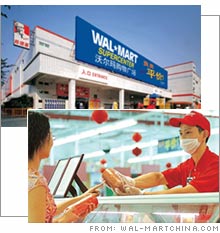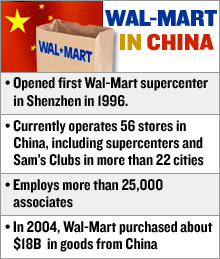|
Wal-Mart's challenge in China
Unlike at home, analysts say Wal-Mart faces tough competition from European and Chinese players.
NEW YORK (CNNMoney.com) - Wal-Mart may rule the retail roost at home, but establishing that same kind of dominance in China won't be easy. Several European supermarket operators as well as a handful of Chinese supermarket chains are all expanding there at a fast clip, jostling for early dominance in this fast-growing market.
Some industry watchers say Wal-Mart (Research) could find itself overshadowed in China as companies like Tesco, Carrefour and Metro push even harder to increase their market share. Wal-Mart (Research) currently operates 56 stores in China, including its supercenters that sell groceries and its Sam's Club warehouse stores. By comparison, French retailer Carrefour already has more than 240 supermarkets and discount stores in the country. UK's No.1 supermarket chain Tesco operates about 50 Chinese "hypermarkets" -- which are large size supercenters typically between 120,000 to 140,00 square feet -- in partnership with China's Hymall grocery store chain. Tesco said it plans to open 15 new stores in 2006. And Germany's largest retailer Metro has 30 discount, cash-only stores in China. Metro spokesman Albrecht Von Truchsess said the company is targeting 6 to 8 news stores a year over the next three to four years. Wal-Mart has not disclosed its China expansion plans for 2006. However, company spokeswoman Beth Keck dismissed the notion that Wal-wasn't growing fast enough. "We did start out slow, but this is a big market with strong growth opportunity for us. We think we have excellent formats that will work very well there." China's a retail gold mine
Based on 2005 estimates, consulting firm Retail Forward ranks China as the seventh largest retail market in the world, behind the United States, Japan, the United Kingdom, Germany, France and Italy. Given the market's rapid growth, China could surpass both Italy and France to claim the No. 5 slot within the next four years. Frank Badillo, senior economist and director of Retail Forward's global research program, points out that China's market for retail goods has been growing at an annual rate of 7 percent for the past five years. That compares with a 5 percent annual growth rate for the U.S. retail market. Wal-Mart already operates more than 3,700 stores in the United States, 2,400 stores in 15 international markets and employs a whopping 1.6 million "associates" worldwide. But its gigantic U.S. footprint has repeatedly sparked Wall Street concerns that its home base is perilously close to saturation -- this despite the fact that it continues to open new stores in the U.S. and it's still pulling in double-digit annual revenue growth. "In the short run, Wal-Mart still has more room to expand in the U.S.," Badillo conceded. "But after about five years, that pace will slow and it will have to focus on the global opportunities." Competition heating up
It's hard to ignore a market of 1.2 billion consumers and a growing middle-class with higher disposable incomes. Global consulting firm Bain & Co. estimates that the number of China's middle-class households will nearly triple by 2010, and their spending will surpass $500 billion. In an interview with the Observer this week, Tesco's CEO Terry Leahy said the retailer was moving full steam ahead to bulk up its business in China. Said Badillo, "Tesco's entry is particularly ominous for Wal-Mart. Even though the company is not as big as Wal-Mart or Carrefour, it's proven it can successfully expand internationally, particularly in Eastern Europe, and in Korea where Wal-Mart's struggled." What can Wal-Mart do? Badillo suggests Wal-Mart should mirror Carrefour's strategy of mixing up its store formats to quickly penetrate both large and small markets in China, rather than focusing on opening more big-box supercenters that are primarily skewed toward larger cities. Moreover, Wal-Mart can emulate Metro's strategy by joining forces with local developers as a means to bypass local bureaucratic traps and procure prime locations. Chinese companies are flexing their muscle, too
According to Bain, Chinese retailers dominate more than 90 percent of local retailing in the country, and maintain a substantial cost advantage over their International rivals. Observers say Wal-Mart, Carrefour and others simply don't have the scale -- yet -- in China to compete on price versus home-grown supermarket chains like WuMart or the Lianhua Supermarket Co. Also vying for retail dollars are China's ubiquitous street markets, or "wet markets" that sell everything from fresh fish and live chickens to mammals and reptiles for consumption. Ira Kalish, director of global economic research with Deloitte Research, said Wal-Mart can't discount the threat from these types of local vendors either. "Chinese consumers are very sensitive to quality and freshness of food," Kalish said. "These vendors also have extremely low overhead, so their prices are also very, very low. Wal-Mart, which sells food, meat and dairy products in its supercenters in China, may not be able to match the street market sellers on freshness and price, but it can compete on quality, hygiene and the convenience of a one-stop shop, he said. The dragon versus the tiger
The Chinese market presents unique cultural, infrastructure and bureaucratic hurdles not just for Wal-Mart but for all foreign retailers, said Jay McIntosh, director of retail and consumer products with Ernst & Young. Kalish agreed. "Companies there have to deal with corruption and piracy issues. It's also hard to attract and retain skilled managers. Chinese workers are not terribly loyal. So international companies are spending lots of money training workers only to lose them." Instead, McIntosh said he's more excited about China's next door neighbor India. "No doubt China is very important to American companies looking to expand globally, but India may be a better [opportunity] once the government relaxes its regulations," he said. Current Indian regulatory policies bar international retailers from directly entering the Indian market, but they can operate in the country via a joint-venture with local partners. Wal-Mart executives have repeatedly indicated the company's interest in setting up shop on the subcontinent provided the regulatory hurdles are removed. "Our research shows that the Indian population tends to spend more and save less versus Chinese consumers who save up to 40 percent of their income," McIntosh said. "Also, a typical retail store in India is tiny, mostly mom and pop and specialty store," he added. "This gives foreign retailers the opportunity to go in and compete in any number of ways. They can set up the one-stop shopping destinations like supercenters, or smaller discount store formats like Wal-Mart's neighborhood markets." Carrefour could not be reached for comment. ____________________________________________ Who are tomorrow's hot retailers? Click here to find out. Wal-Mart's hot on India. Click here for more.
Is India's outsourcing honeymoon over? Click here for more. |
|


